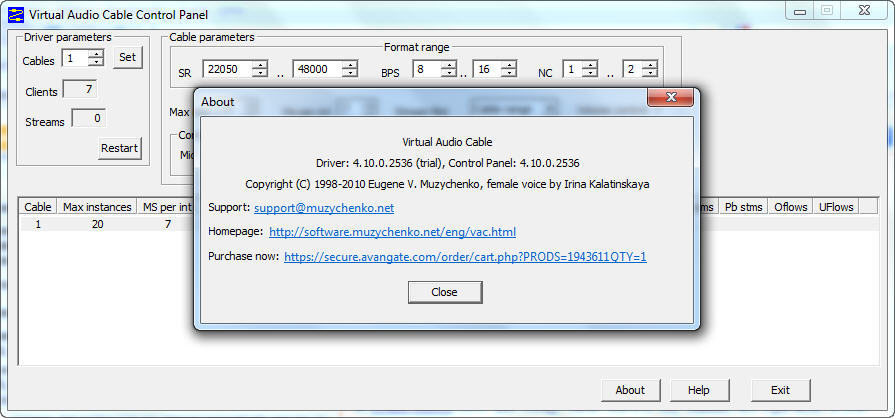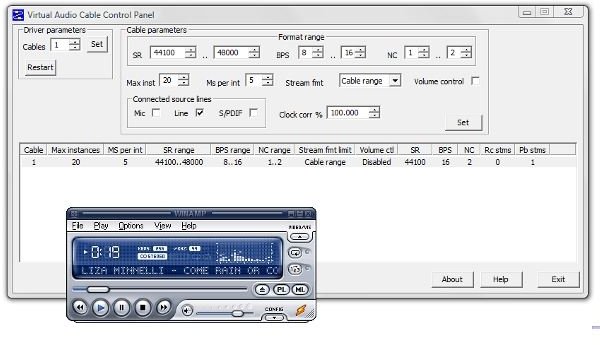

- #AUDIO REPEATER VIRTUAL AUDIO CABLE TRIAL INSTALL#
- #AUDIO REPEATER VIRTUAL AUDIO CABLE TRIAL DRIVER#
- #AUDIO REPEATER VIRTUAL AUDIO CABLE TRIAL PORTABLE#
- #AUDIO REPEATER VIRTUAL AUDIO CABLE TRIAL SOFTWARE#
It's a little complicated, but perfectly logical: now all your USB mics are getting virtually combined into one audio input (going to the studio), and all your USB headphones are getting the same virtual audio output (coming from the studio). Now open Skype and click Tools > Options, and under General > Audio Settings change the Microphone to be set to Virtual Cable 1 and the Speakers to be Virtual Cable 2. But for additional microphones (like "crowd sound" mics) with no headphones, you only need one additional instance - follow the guidelines under "USB Microphones" above.

Remember: for each additional headset, you'll need two more instances of Audio Repeater MMC running. This time your Wave In is Virtual Cable 2 for both instances, and then Wave Out goes to Logitech USB Headset and Logitech USB Headset (2).įor each of the four instances, when you set one up, click the instance's START button (lower-right corner of the instance's window) and then start another instance by clicking (Windows) Start > Programs > Virtual Audio Cable > Audio Repeater MMC. The other two instances combine the Skype call's output (from the studio) into one virtual cable so both headsets hear the same thing from the studio. Two instances will combine your Logitech USB Headset and Logitech USB Headset (2) under Wave In into one virtual audio source for Skype to use: call this Virtual Cable 1 under Wave Out for both instances. You should be able to use the default settings for all save one: Channel Config should be set to Mono.
#AUDIO REPEATER VIRTUAL AUDIO CABLE TRIAL INSTALL#
Once you install VAC, for two headsets you'll need a minimum of two virtual cables created by four "Audio Repeater MMC" instances from the VAC start menu. AND it will seamlessly recognize two headsets and label the second accordingly.
#AUDIO REPEATER VIRTUAL AUDIO CABLE TRIAL DRIVER#
I chose the Logitech H530 because there's easy-to-use-by-touch controls for volume up/down and mute on the headset itself, and on Windows XP and up, the driver will automatically install just from plugging in the headset to a USB port. The setup will be different than described below, but the overall concept should be roughly similar, even if the implementation is completely different. Update: Feb.2014: I found a free/donationware program called VB-Audio Cable, seems to work well on 64bit Windows 7, at least.
#AUDIO REPEATER VIRTUAL AUDIO CABLE TRIAL SOFTWARE#
For Windows, you'll need third-party software I used Virtual Audio Cable (VAC) 4.12 (it's not free, but it's pretty cheap.$25 to $50 depending on the support level you choose.and there's a free limited trial you can use for proof-of-concept on your own gear).
#AUDIO REPEATER VIRTUAL AUDIO CABLE TRIAL PORTABLE#
Very, very few portable mixers are designed to handle more than one headphone output (i.e. It's impossible to know for sure until you try it in a live situation, so have some kind of backup ready (see below).

The former I can't say much about here, save that with 4G hotspots, things have gotten pretty solid on that front for SOME areas of the country on SOME carriers. The two biggest catches were the reliability of the internet connection, and the need for external mixing. With a little luck, the whole system could be assembled for very little cash, especially if you could finagle the laptop for cheap/free from your campus IT department. With a good internet bandwidth, the connection was fairly reliable. The delay was low enough (just barely) for bidirectional communication.

The SILK codec that Skype uses is pretty good quality.certainly good enough for broadcast. Can it be done? Yes it can! But there are some minor caveats - read on to see how it works. Towards the end, one technology we started looking more at was simply using a netbook and Skype to get audio back to the studio. As such, I got to know a lot of different ways to get audio reliably from the field back to the studios. During my time at WEOS/ WHWS (2007-11) we carried a LOT of live sportscasts, usually over 100 each academic year.


 0 kommentar(er)
0 kommentar(er)
